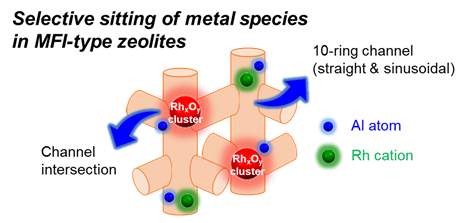2020 Virtual AIChE Annual Meeting
(387b) Metal Cation-Exchanged Zeolites with the Location, State and Size of Metal Species Controlled
Authors
Our strategy for this study is based on the framework Al distribution because the introduced metal cation should exist around Al3+ species to balance the negative charge of the zeolite framework. Previously, our group reported the synthesis of MFI-type aluminosilicate zeolites with the different framework Al distributions by a rational selection of the cations. It is noted that the location of the exchanged metal-cations depends on the framework Al distribution. Moreover, the zeolite-supported Rh sub-nano cluster was obtained by the ion-exchange method in the previous work. In this case, the size of the Rh cluster might be affected by the space size of the ion-exchange sites (Al3+ sites). Accordingly, we applied the MFI-type aluminosilicate with the different framework Al distributions to Rh ion-exchanged zeolites.
Consequently, the synthesized Rh ion-exchanged MFI-type aluminosilicate zeolites with the different framework Al distributions showed the different catalytic activity for the oxidative reforming of methane. The MFI-type aluminosilicate zeolite with the framework Al atoms mainly located in the channel intersections gave the formation of relatively large Rh species, which were confirmed by UV-vis and in-situ CO adsorption IR techniques. In addition, it showed remarkably high catalytic activity for the reaction. These results revealed that the location of the framework Al species is one of the important factors for controlling the location, size, and state of the metal species in the metal cation-exchanged zeolites. Thus, we succeed in the synthesis of a new class metal cation-exchanged zeolite.
